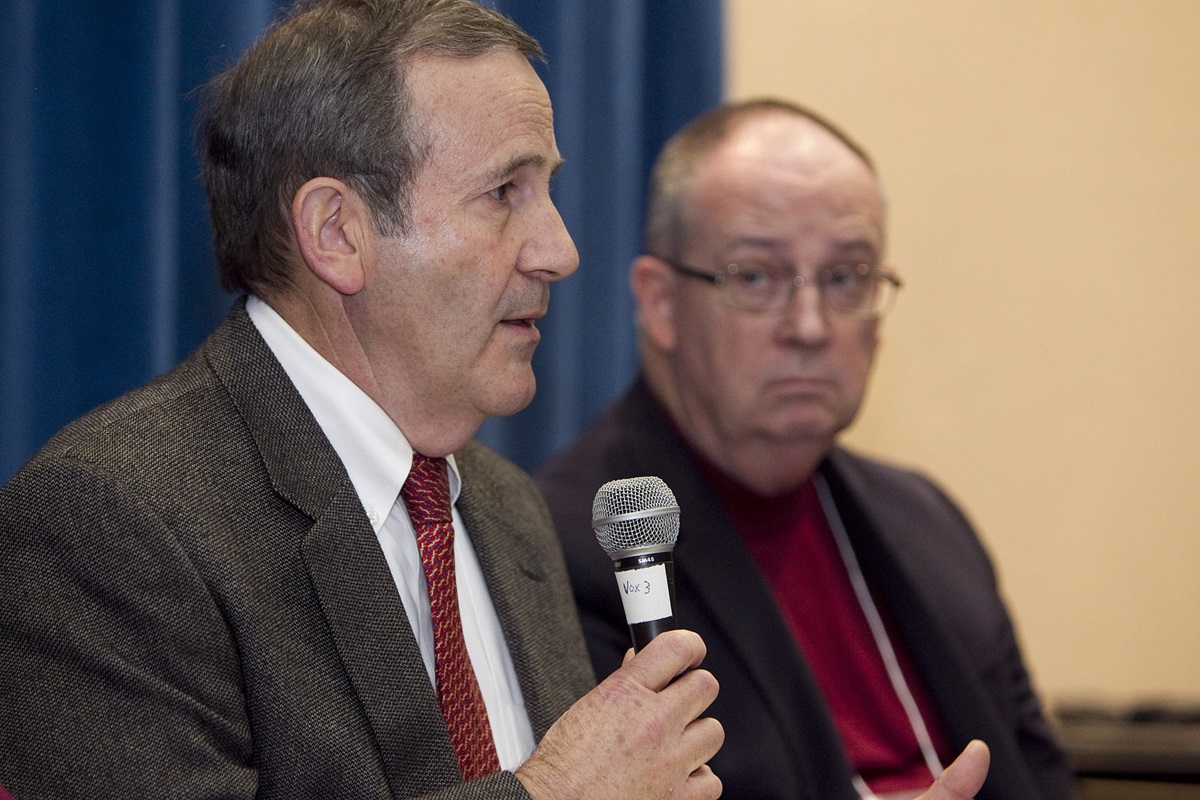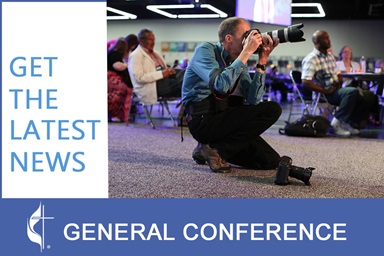The United Methodist Church has only 15 years to reverse its decline in the United States if it is to have a sustainable future, an economist warned church leaders.
At the same gathering, the church leaders discussed possible missional goals to address that decline and enhance the global denomination’s ministries around the world.
“By 2030, the denomination in the United States will either have found a way to turn around, meaning it is growing, or its turnaround in the United States is not possible,” Donald R. House Sr. told the May 19 combined meeting of the Connectional Table and the General Council on Finance and Administration board. “By 2050, the connection will have collapsed.”
In other words, he predicted that unless things change soon, the denomination in coming decades will not have enough U.S. churches to pay for its connectional structures. Such structures include conferences, bishops, agencies, missions and international disaster response.
His presentation came a week after the Pew Research Center released its 2014 religious landscape survey, showing the share of U.S. adult population that’s mainline Protestant had dropped from 18.1 to 14.7 percent in the previous seven years. The survey counted United Methodists among the mainline Protestants.
House — a lifelong United Methodist — holds a Ph.D. in economics and chairs the denomination’s eight-member Economic Advisory Committee, whose projections help shape the general church’s budget every four years.
House also holds other United Methodist leadership roles, including chair of the South Central Jurisdiction episcopacy committee that oversees the work of that region’s bishops.
In addition, he is one of the drafters of the revised Plan UMC, proposed legislation to reorganize the denomination’s general agencies. The Council of Bishops earlier this month took the unusual step of asking the denomination’s top court to determine if the legislation is constitutional before it goes before the 2016 General Conference.
He addressed the two bodies that put together the general church budget that goes before General Conference, the denomination’s top lawmaking assembly.
House said he based his long-term attendance and financial projections on the denomination’s U.S. statistical trends because the denomination has incomplete data from many of its churches around the globe. But membership data shows The United Methodist Church is growing worldwide.
At this point, the U.S. membership supports the bulk of general church finances.
What he forecasts, he admitted, is “tough stuff” for church leaders to hear. Still, he also offered hope that the United Methodists can return to a trajectory of growth in the United States and fulfill its mission to make disciples of Jesus Christ.
But it will mean ministering to a church with different needs and much more ethnic diversity than found during the denomination’s last growth period in the 1950s.
Dallas Area Bishop Michael McKee, a General Council on Finance and Administration board member, told those gathered he does not see House’s report “as gloom and doom.”
“In some respects, we’ve been trying to recover what we’ve had,” McKee said. “Maybe the voice of God is directing us to have a new church. I think we’ll have a better church, but I agree we’re not there yet.”
Approving a Budget
The Connectional Table and General Council on Finance and Administration board approved a proposed budget of $611 million for general church funds in 2017-20.
That’s about a 1.3 percent increase above the $603.1 million general church budget approved at the 2012 General Conference.
But accounting for an annual U.S. inflation rate of 2 percent, the total budget actually marks a reduction in spending in terms of real dollars.
It is also more conservative amount than the $621 million “realistic budget proposal” suggested by the Economic Advisory Committee.
At the general church level, the budget supports seven apportioned funds. These include bishops, United Methodist ministerial education, 10 general agencies and denomination-wide efforts such as the Black College Fund and Africa University in Zimbabwe.
The Rev. Steve Wood, a General Council on Finance and Administration board member, asked Donald R. House Sr., given his projections, what he thought of increasing the denomination’s general church budget. Wood is also the lead pastor of Mount Pisgah United Methodist Church in Johns Creek, Georgia.
House noted that economic conditions are improving, and the church has seen increasing payout rates to general church ministries.
“The question is where do we think the money can best be spent,” House said. “Is it to be in annual conferences? Is it to be in local churches? Is it to be in general agencies? I’ve been around for a while and I think there is work for the general agencies.”
He said he thinks agencies can help in providing resources for the turnaround and increasing vital congregations.
The challenges the church faces
For the last 10 years, General Council on Finance and Administration statistics show, United Methodist worship attendance in the United States has decreased on average 52,383 per year.
Between 1974 and 2012, the U.S. church lost 18 percent in worship attendance. During the same period, House noted, the number of U.S. churches shrank by 16 percent, the number of conferences by 19 percent and the number of districts by 21 percent.
“What we are doing is disassembling our infrastructure faster than we are experiencing decline in the U.S.,” he said. “If this were a business model, I’d say you were gracefully closing your doors.”
But that’s not the way to reverse decline, he said.
Part of the problem, House said, is the denomination has church buildings that were in the right locations for 1952 but not for today. He recommended United Methodists focus on planting new churches and especially reinvigorating the congregations they already have.
“You can’t new-church-start your way out of this existing crisis,” he said.
What the denomination needs are nationally scalable strategies for revitalization, House said. He is testing one such strategy now.
His plan, “The Benchmark Project,” calls for nearly 1,000 churches with at least 125 members to raise and spend $119.5 million a year more to address what he says are deficiencies in investment such as lay staff members. He has received $100,000 from the Connectional Table to help fund the study.
He first hopes to have 217 churches in the South Central Jurisdiction taking part in the study by 2017.
So far, he has 16 churches participating with commitments from the Arkansas, Oklahoma and Great Plains conferences to join. He expects the study to continue through 2024. Three pilot churches in his home Texas Conference, he said, are already showing good results.
Possible missional goals
Church leaders also talked about missional goals that will be presented to the 2016 General Conference as part of the proposed 2017-20 budget.
Chicago Area Bishop Sally Dyck presented the goals being considered by the Council of Bishops and Connectional Table, which coordinates the work of general church agencies. Each goal is aligned with the denomination’s four areas of ministry focus and its drive to increase the number of highly vital congregations.
“This is so the work of the church through our apportioned giving is aligned around these missional goals,” she told United Methodist News Service. “In the agencies and hopefully in our annual conference budgets, we begin to see these as an alignment of our work.”
The current plan calls for United Methodists in the next four years to:
Start two new faith communities a day
Create a culture of call in every faith community
Reach 1 million children with life-saving health interventions
Partner with 30,000 schools to help end poverty
Double the number of vital congregations by equipping congregations with disciple making practices
She said some goals, such as creating a culture of call, are still being refined so they can have measurable results. “We want to measure our success,” she said.
“This is a big step forward in terms of working together to come up with some internal goals that will help focus our work and will make a difference in our communities,” the bishop said.
“Hopefully, people will say: ‘Wow, those United Methodists. They’re working with us in our schools. They’re starting new faith communities all over the place.’”
Hahn is a multimedia news reporter for United Methodist News Service. Contact her at (615) 742-5470 or newsdesk@umcom.org.
Like what you're reading? Support the ministry of UM News! Your support ensures the latest denominational news, dynamic stories and informative articles will continue to connect our global community. Make a tax-deductible donation at ResourceUMC.org/GiveUMCom.




